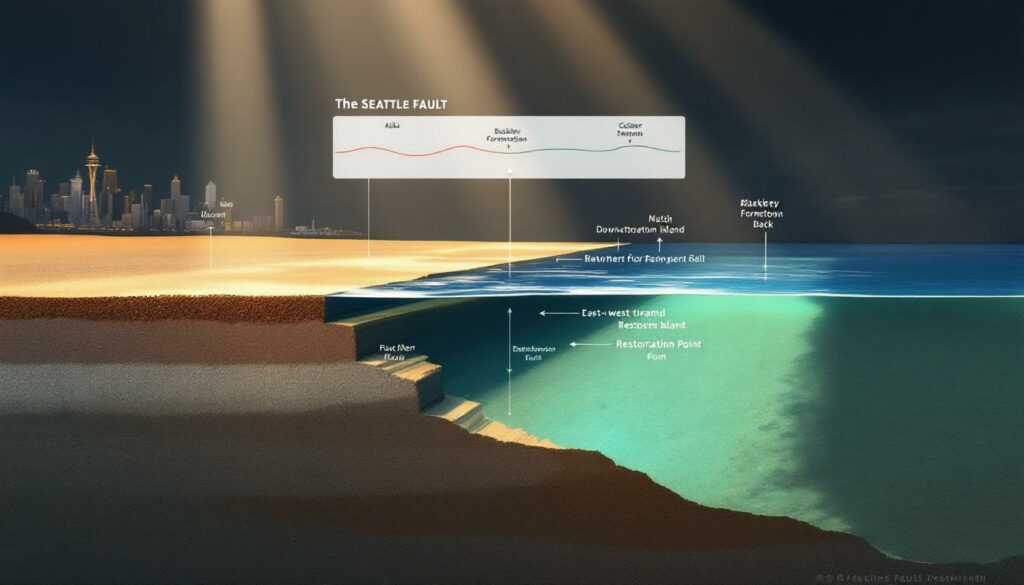Understanding the Blakeley Formation and Seattle Fault: Geological Marvels of Western Washington
The geological landscape of Western Washington tells a complex story spanning millions of years, with the Blakeley Formation and Seattle Fault serving as critical chapters in this narrative. These features provide rare glimpses into the region's ancient past and ongoing tectonic activity, offering valuable mineral exploration insights for both researchers and curious observers. This article explores their significance, characteristics, and the scientific discoveries they continue to reveal.
What Is the Blakeley Formation?
The Blakeley Formation represents one of Western Washington's most significant yet understudied geological features. Dating back approximately 30-35 million years to the Oligocene epoch, this formation provides a rare window into the region's distant past.
Origin and Geological Classification
The Blakeley Formation is primarily a marine sedimentary rock unit, composed of sandstone that formed in a shallow marine environment during the Oligocene period. Unlike many formations in the region, it predates the development of the modern Cascade Range and represents conditions that existed when much of western Washington lay beneath a shallow sea.
"The Blakeley Formation is mostly poorly understood," notes geologist Nick Zentner, highlighting the untapped research potential of these ancient rocks. What makes this formation particularly special is its status as one of the few accessible bedrock exposures in a region otherwise dominated by much younger glacial deposits.
Composition and Physical Characteristics
Close examination reveals a surprisingly dense sandstone with distinctive "sparkly little sand grains" compacted into a hard, resistant rock. The formation typically exhibits a light tan coloration when freshly exposed and appears as flat, continuous bedrock surfaces at its outcrop locations.
The sandstone is notably sturdy, requiring significant force with a geologist's hammer to break off samples. This density and durability have helped preserve the formation despite millions of years of geological processes, including glaciation and tectonic activity.
Where Can You Find the Blakeley Formation?
Despite being millions of years old, the Blakeley Formation makes limited appearances in today's landscape, with just a few key locations where observers can see this ancient bedrock.
Alki Point Exposure
One of the most accessible exposures of the Blakeley Formation occurs at Alki Point in West Seattle. Interestingly, this bedrock is only visible during low tide, when the retreating waters reveal the ancient sandstone shelf beneath the typical beach environment. During high tide, the formation disappears entirely beneath the waters of Puget Sound.
At Alki, the formation appears as flat, tan-colored bedrock surfaces distinctly different from the scattered glacial stones that surround it. Marine organisms like barnacles and small tidal creatures often cling to these surfaces, waiting for the next high tide.
Restoration Point Location
Across Elliott Bay on Bainbridge Island, Restoration Point provides another significant exposure of the Blakeley Formation. This location has historical significance, having been documented by early explorers including George Vancouver during his expeditions in the 1790s.
"Alki Point and Restoration Point are two little islands of bedrock surrounded by a sea of glacial deposits," explains Zentner, highlighting how unusual these exposures are in the context of the Puget Sound region's predominantly glacial landscape.
Distinguishing Features in the Field
For the casual observer, identifying the Blakeley Formation requires careful attention to distinguish it from loose beach rocks. The formation appears as continuous bedrock surfaces with consistent coloration and texture. This contrasts sharply with glacial erratics, which showcase varied colors and compositions, having been transported from Canada during ice ages within the past 3 million years.
The bedrock's light tan color and relatively uniform appearance provide key identification markers for field geologists and curious visitors alike.
How Does the Seattle Fault Influence the Blakeley Formation?
The exposure of the Blakeley Formation at locations like Alki Point is no geological accident. Instead, it's the direct result of dramatic tectonic activity along one of the region's most significant fault systems.
The Seattle Fault System Explained
The Seattle Fault represents a major east-west trending seismic structure running through the Puget Sound region. Unlike the deeper Cascadia Subduction Zone offshore, the Seattle Fault is a shallow crustal feature resulting from regional compression and clockwise rotation of crustal blocks within the North American plate.
This fault system creates a distinct boundary between uplifted areas to the south and downthrown blocks to the north. The difference is stark: south of the fault, bedrock like the Blakeley Formation reaches the surface, while north of the fault, similar rock units remain buried "thousands of feet below the surface," according to geological surveys.
Uplift Mechanisms and Evidence
"This bedrock is exposed at Alki because of the repeated earthquake action on the Seattle Fault," Zentner explains. The southern block has experienced multiple uplift events during major seismic episodes, gradually raising the bedrock that would otherwise remain deeply buried.
Each earthquake along the fault contributes to this differential movement, with the southern block (including Alki Point) moving upward relative to the northern block (including downtown Seattle). Over millions of years, this process has literally brought the ancient Blakeley Formation to light.
Historical Seismic Events
Research by geologists including Brian Atwater has documented that the most recent major earthquake on the Seattle Fault occurred approximately 1,100 years ago (around 900 CE). This event caused dramatic and sudden uplift—approximately 21 feet of vertical displacement occurred in a single seismic event, dramatically altering the coastal landscape.
"Twenty-one feet of sudden lifting happened in that event 1,100 years ago," notes Zentner, emphasizing the extreme nature of this geological event.
This evidence provides crucial insights into the potential magnitude of future earthquakes on the Seattle Fault, making the exposed Blakeley Formation not just a window into the deep past but also a key to understanding future seismic hazards for the Seattle metropolitan area.
What Is the Stratigraphic Context of the Blakeley Formation?
Understanding where the Blakeley Formation fits within the region's geological timeline helps reveal its broader significance and relationship to other rock units throughout Washington.
Regional Stratigraphic Relationships
The Blakeley Formation exists within a complex sequence of sedimentary and volcanic units spanning from approximately 60 to 30 million years ago in western Washington. While officially separate from the Puget Group (which lies below it stratigraphically), the Blakeley Formation represents part of the broader depositional history of the region during the Oligocene period.
According to field observations, the Blakeley Formation sits stratigraphically above the Puget Group but is "officially not part of it," representing a distinct depositional period with its own unique characteristics.
Contemporaneous Formations
Several formations developed contemporaneously with the Blakeley Formation across western and central Washington, including:
- The Ohanapecosh Formation in the Cascade region (submarine volcaniclastic deposits)
- The Lincoln Creek Formation near Interstate 5
- The Summit Creek Sandstone exposed at White Pass
- The Wenatchee Formation in central Washington
These units, while forming at roughly the same time (30-35 million years ago), represent different depositional environments across what would eventually become Washington State. The Blakeley Formation specifically represents the marine environment that existed in the western portion of the region.
Depositional Environment Interpretation
Evidence suggests the Blakeley Formation represents marine sand deposits laid down during a time when much of western Washington existed as a shallow marine environment. This period coincided with submarine volcanism to the east in what would later become the Cascade Range, though significant mountain-building had not yet occurred.
"During the Ohanapecosh time… there was no major elevation in Washington," explains Zentner, painting a picture of a landscape vastly different from today's mountainous topography. The Blakeley Formation thus preserves evidence of this ancient marine environment before the rise of the modern Cascade Range.
Why Is the Blakeley Formation Scientifically Important?
Despite its limited exposure, the Blakeley Formation holds significant scientific value for understanding western Washington's geological evolution.
Research Opportunities
The Blakeley Formation remains relatively understudied compared to other geological units in the region, offering significant opportunities for new research. "Nobody's really worked on it quite yet until now," notes Zentner, highlighting the untapped potential of these ancient rocks.
Key areas for investigation include:
- Precise dating through volcanic ash layers
- Correlation with contemporaneous formations across Washington
- Detailed stratigraphic analysis to understand depositional environments
- Tectonic reconstruction of the pre-Cascade landscape
These research directions could significantly enhance our understanding of western Washington's geological evolution during a critical transitional period.
Tephrochronology Potential
Volcanic ash layers potentially preserved within the Blakeley Formation could provide precise dating and correlation tools. By identifying and dating these ash layers, researchers could establish time-equivalent relationships between scattered exposures across western Washington, creating a more comprehensive regional stratigraphic framework.
This approach, known as tephrochronology, uses the unique chemical fingerprints of volcanic ash layers as chronological markers, allowing geologists to determine precisely when sediments were deposited and how they correlate with other formations across the region.
Current Research Initiatives
New research efforts are emerging to address gaps in understanding the Blakeley Formation. Notably, Dr. Erin Donaghy from the University of Nevada, Las Vegas, is planning field investigations of the formation. Her work represents the next chapter in understanding these ancient rocks and their significance to the region's geological story.
As Zentner notes regarding Dr. Donaghy's planned work: "She's trying to work out in the Olympic Peninsula… and also the Blakeley Formation," suggesting an integrated approach to understanding regional geological relationships.
How Does the Blakeley Formation Fit Into Washington's Geological History?
The Blakeley Formation provides a crucial piece in the puzzle of Washington's long-term geological evolution, particularly during the transition from ancient marine environments to the development of the modern Cascade Range.
Pre-Cascade Landscape
The Blakeley Formation was deposited during a critical transitional period in Washington's geological evolution. During this time (approximately 30-35 million years ago), the modern Cascade Range had not yet developed as a significant topographic feature. Instead, the region featured submarine volcanic activity without major elevation differences.
This pre-Cascade landscape looked dramatically different from today's Washington. Where mountains now stand, shallow seas once existed, gradually accumulating the sediments that would eventually become the Blakeley Formation.
Relationship to Cascade Volcanism
While contemporaneous with early Cascade volcanic activity, the Blakeley Formation represents offshore marine deposition rather than direct volcanic output. The formation helps document the broader geological context in which early Cascade volcanism occurred, before the development of the modern volcanic arc.
During this period, volcanic activity occurred primarily underwater, with submarine eruptions contributing to formations like the Ohanapecosh in what would later become the Cascade Range. The Blakeley Formation, developing simultaneously but in a different environment, provides complementary evidence for understanding this transitional period.
Tectonic Evolution Context
The presence and current position of the Blakeley Formation provide important evidence for understanding the complex tectonic evolution of the Pacific Northwest. Its uplift along the Seattle Fault demonstrates the ongoing crustal deformation affecting the region, part of the broader plate tectonic processes shaping western North America.
The rocks themselves record a time before significant tectonic compression and rotation had created today's landforms, offering a baseline against which later geological changes can be measured.
What Can We Learn From Studying the Blakeley Formation?
Beyond its intrinsic scientific value, the Blakeley Formation provides practical insights relevant to the Seattle region and beyond.
Earthquake Hazard Assessment
The exposure of the Blakeley Formation at locations like Alki Point provides crucial evidence for understanding the Seattle Fault's seismic history. By studying these uplifted blocks, geologists can reconstruct the timing, magnitude, and recurrence intervals of major earthquakes, contributing to seismic hazard assessments for the Seattle metropolitan area.
The dramatic 21-foot uplift documented from the earthquake around 900 CE demonstrates the significant seismic potential of the Seattle Fault, information vital for modern earthquake preparedness and infrastructure planning.
Paleoenvironmental Reconstruction
Detailed analysis of the Blakeley Formation's sedimentary characteristics, fossil content, and stratigraphic relationships can help reconstruct the environmental conditions of western Washington during the Oligocene period. This information contributes to our understanding of how the region's climate and geography have evolved over millions of years.
The marine sandstone composition indicates a shallow sea environment, vastly different from today's landscape, highlighting the dramatic environmental changes that have shaped the Pacific Northwest.
Regional Correlation Potential
As research on the Blakeley Formation advances, correlations with other contemporaneous units across Washington may emerge. These connections could help establish a more comprehensive understanding of the region's geological evolution during a critical period before the development of the modern Cascade Range.
The potential discovery of datable volcanic ash layers within the formation would be particularly valuable, providing precise time markers that could link geological events across wide geographic areas.
How Do Glacial Deposits Relate to the Blakeley Formation?
The relationship between the ancient Blakeley Formation and much younger glacial materials tells a story of time and geological processes that shaped the modern Puget Sound landscape.
Distinguishing Glacial Material
The Puget Sound region is predominantly covered by glacial deposits from multiple ice age advances within the past 3 million years. These deposits consist of rocks transported from Canada by massive ice sheets, creating a diverse collection of erratics with varied compositions and origins.
As Zentner explains: "The tan bedrock is more than 30 million years old. The loose stones were brought in here less than three [million years] during the ice age." This striking age difference—bedrock at 30+ million years versus glacial materials at less than 3 million years—illustrates the complex geological history preserved at sites like Alki Point.
Stratigraphic Relationship
Glacial deposits typically overlie the Blakeley Formation where both are present, representing a significant unconformity (gap in the geological record) of approximately 27-30 million years. This relationship illustrates the complex geological history of the region, with ancient marine sediments now exposed due to tectonic activity and partially covered by much younger glacial materials.
This unconformity represents a period when erosion rather than deposition dominated the region, or when any deposited materials were subsequently removed before glaciation began.
Landscape Evolution Implications
The interaction between exposed bedrock like the Blakeley Formation and overlying glacial deposits helps document the complex landscape evolution of the Puget Sound region. This relationship demonstrates how tectonic uplift, erosion, and glacial deposition have combined to create the modern landscape of western Washington.
At locations like Alki Point, the juxtaposition of ancient bedrock and recent glacial materials creates a visible timeline spanning tens of millions of years—a rare opportunity to observe such drastically different geological eras in close proximity.
What Are the Future Research Directions?
Despite its scientific significance, the Blakeley Formation and the Seattle Fault remain incompletely understood, with numerous opportunities for future research and discovery.
Dating and Correlation Opportunities
Future research on the Blakeley Formation may focus on precise dating of volcanic ash layers within the formation. This tephrochronology approach could help establish correlations between scattered exposures across western Washington, creating a more comprehensive regional stratigraphic framework.
The identification of ash layers with distinctive chemical signatures would allow researchers to link the Blakeley Formation with contemporaneous deposits elsewhere in the Pacific Northwest, potentially revealing regional patterns in sedimentation, volcanism, and tectonic activity.
Detailed Stratigraphic Analysis
More detailed stratigraphic work on the Blakeley Formation could reveal subtle variations in depositional environments, sediment sources, and paleoclimatic conditions. This information would contribute to a more nuanced understanding of western Washington's geological evolution during the Oligocene period.
Centimeter-by-centimeter analysis of the formation's layers could reveal cycles of environmental change, evidence of ancient storms or tsunamis, and other details currently hidden within these ancient rocks. Furthermore, comprehensive geological logging codes would help researchers categorize and interpret these findings more effectively.
Integration with Seismic Hazard Assessment
Continued study of the Blakeley Formation's relationship to the Seattle Fault will contribute to improved seismic hazard assessments for the region. By better understanding the timing and magnitude of past earthquakes, geologists can refine predictions about future seismic events that could affect the Seattle metropolitan area.
The formation's unique position as direct evidence of fault movement makes it particularly valuable for understanding the long-term behavior of the Seattle Fault and its potential impact on regional seismic hazards. In addition, thorough drilling results interpretation from the area can provide further insights into the subsurface structure.
FAQ About the Blakeley Formation and Seattle Fault
How old is the Blakeley Formation?
The Blakeley Formation dates to approximately 30-35 million years ago during the Oligocene epoch, making it significantly older than the glacial deposits that cover most of the Puget Sound region.
Why is bedrock so rare in Seattle?
Bedrock exposures are uncommon in Seattle because most of the region is covered by thick glacial deposits left by multiple ice age advances within the past 3 million years. Only in areas of significant tectonic uplift, like south of the Seattle Fault, does bedrock reach the surface.
When was the last major earthquake on the Seattle Fault
Ready to Spot the Next Major Mineral Discovery?
Don't miss out on significant ASX mineral discoveries as they happen! Discovery Alert's proprietary Discovery IQ model instantly identifies high-potential mineral announcements, transforming complex data into actionable investment insights. Visit our discoveries page to understand why historic discoveries can generate substantial returns and start your 30-day free trial today.




